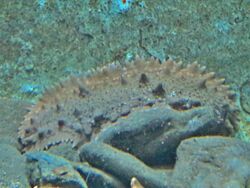Biology:Parastichopus regalis
| Parastichopus regalis | |
|---|---|

| |
| Scientific classification | |
| Domain: | Eukaryota |
| Kingdom: | Animalia |
| Phylum: | Echinodermata |
| Class: | Holothuroidea |
| Order: | Synallactida |
| Family: | Stichopodidae |
| Genus: | Parastichopus |
| Species: | P. regalis
|
| Binomial name | |
| Parastichopus regalis | |
| Synonyms | |
| |
Parastichopus regalis, also known as the royal sea cucumber, is a species of sea cucumber in the family Stichopodidae.
Description
Parastichopus regalis grows to a length of about 20 cm (8 in). The body is soft and somewhat flattened, and a clearly incised lateral fold with large papillae separates the dorsal surface from the ventral surface. The dorsal surface is mottled brown, and the ventral surface is rather paler, with a darker longitudinal streak in the centre. The bony sclerites that strengthen the integument include tables, terminal plates and perforated plates; the sclerites in the tentacles that surround the mouth include elongated, branched, perforated and arched rods.[3]
Distribution and habitat
Parastichopus regalis is found in the Mediterranean Sea, along the coasts of Africa in the eastern Atlantic Ocean, and in the tropical and subtropical western Atlantic Ocean, including the Gulf of Mexico. It is typically found on sand or other soft substrates,[4] at depths down to about 800 m (2,600 ft); it is commonest in the 100 to 300 m (300 to 1,000 ft) depth range. [5]
Ecology
In a commensal arrangement, Parastichopus regalis is often host to the pearlfish Carapus acus, which enters the sea cucumber's respiratory tree via its anus. The fish lives inside the sea cucumber during the day, emerging into the open water at night to feed. Two fish may occupy a single host, and a pair have been known to breed inside their host.[6] When stressed, it autotomises its internal organs, regenerating them again later.[6]
Status
This sea cucumber is a common species. It is edible and is eaten in parts of its range but is not a targeted species, being caught as bycatch during deepwater trawling.[1]
References
- ↑ 1.0 1.1 Mercier, A.; Hamel, J.-F. (2013). "Parastichopus regalis". IUCN Red List of Threatened Species 2013: e.T180298A1612492. doi:10.2305/IUCN.UK.2013-1.RLTS.T180298A1612492.en. https://www.iucnredlist.org/species/180298/1612492. Retrieved 20 November 2021.
- ↑ Paulay, Gustav (2021). "Parastichopus regalis (Cuvier, 1817)". WoRMS. World Register of Marine Species. http://www.marinespecies.org/aphia.php?p=taxdetails&id=149898.
- ↑ Benzait, Hocine; Khodja, Ihcene; Soualili, Dina Lila; Mezal, Karim (2020). "Note on Parastichopus regalis (Cuvier, 1817) from the Sidi-Medjdoub area of Mostaganem, Algeria". SPC Beche-de-mer Information Bulletin 40. https://spccfpstore1.blob.core.windows.net/digitallibrary-docs/files/c4/c4929be56fbe32557977997ab9d00e62.pdf?.
- ↑ "Parastichopus regalis (Cuvier, 1817)" (in French). DORIS. 9 November 2020. https://doris.ffessm.fr/ref/specie/852.
- ↑ "Parastichopus regalis (Cuvier, 1817)". SeaLifeBase. https://www.sealifebase.ca/summary/Parastichopus-regalis.html.
- ↑ 6.0 6.1 González-Wangüemert, Mercedes; Maggi, Camilla; Valente, Sara; Martínez-Garrido, Jose; Rodrigues, Nuno Vasco (2014). "Parastichopus regalis — The main host of Carapus acus in temperate waters of the Mediterranean Sea and northeastern Atlantic Ocean". Beche-de-mer Information Bulletin 34. https://pacific-data.sprep.org/system/files/BDM34_38_Gonzales_0.pdf.
Wikidata ☰ {{{from}}} entry
 |


